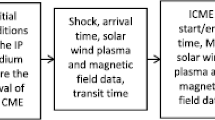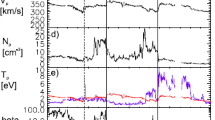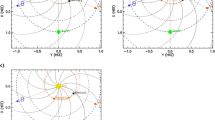Abstract
A sample of isolated Earth-impacting interplanetary coronal mass ejections (ICMEs) that occurred in the period January 2008 to August 2014 is analyzed to study in detail the ICME in situ signatures, with respect to the type of filament eruption related to the corresponding CME. Observations from different vantage points provided by the Solar and Heliospheric Observatory (SOHO) and the Solar Terrestrial Relations Observatory Ahead and Behind (STEREO-A and B) are used to determine whether each CME under study is Earth directed or not. For Earth-directed CMEs, a kinematical study was performed using the STEREO-A and B COR1 and COR2 coronagraphs and the Heliospheric Imagers (HI1), to estimate the CME arrival time at 1 AU and to link the CMEs with the corresponding in situ solar wind counterparts. Based on the extrapolated CME kinematics, we identified interacting CMEs, which were excluded from further analysis. Applying this approach, a set of 31 isolated Earth-impacting CMEs was unambiguously identified and related to the in situ measurements recorded by the Wind spacecraft. We classified the events into subsets with respect to the CME source location, as well as with respect to the type of the associated filament eruption. Hence, the events are divided into three subsamples: active region (AR) CMEs, disappearing filament (DSF) CMEs, and stealthy CMEs. The related three groups of ICMEs were further divided into two subsets: magnetic obstacle (MO) events (out of which four were stealthy), covering ICMEs that at least partly showed characteristics of flux ropes, and ejecta (EJ) events, not showing such characteristics. In this way, 14 MO-ICMEs and 17 EJ-ICMES were identified. The solar source regions of the non-stealthy MO-ICMEs are found to be located predominantly (9/10, 90%) within \(\pm30^{\circ}\) from the solar central meridian, whereas EJ-ICMEs originate predominantly (16/17, 94%) from source regions that are outside \(\pm30^{\circ}\). In the next step, MO-events were analyzed in more detail, considering the magnetic field strength and the plasma characteristics in three different segments, defined as the turbulent sheath (TS), the frontal region (FR), and the MO itself. The analysis revealed various well-defined correlations for AR, DSF, and stealthy ICMEs, which we interpreted considering basic physical concepts. Our results support the hypothesis that ICMEs show different signatures depending on the in situ spacecraft trajectory, in terms of apex versus flank hits.









Similar content being viewed by others
References
Berkebile-Stoiser, S., Veronig, A.M., Bein, B., Temmer, M.: 2012, Relation between the coronal mass ejection acceleration and the non-thermal flare characteristics. Astrophys. J.753, 88. DOI. ADS.
Brueckner, G.E., Howard, R.A., Koomen, M.J., Korendyke, C.M., Michels, D.J., Moses, J.D., et al.: 1995, The Large Angle Spectroscopic Coronagraph (LASCO). Solar Phys.162, 357. DOI. ADS.
Burlaga, L.F.: 1988, Magnetic clouds and force-free fields with constant alpha. J. Geophys. Res.93, 7217. DOI. ADS.
Burlaga, L.F.: 1995, Interplanetary Magnetohydrodynamics, Oxford University Press, Oxford, 272. ADS.
Burlaga, L.F., Sittler, E., Mariani, F., Schwenn, R.: 1981, Magnetic loop behind an interplanetary shock – Voyager, Helios, and IMP 8 observations. J. Geophys. Res.86, 6673. DOI. ADS.
Burlaga, L.F., Skoug, R.M., Smith, C.W., Webb, D.F., Zurbuchen, T.H., Reinard, R.: 2001, Fast ejecta during the ascending phase of solar cycle 23: ACE observations, 1998 – 1999. J. Geophys. Res.106, 20957. DOI. ADS.
Burlaga, L.F., Ness, N.F., Acuña, M.H., Lepping, R.P., Connerney, J.E.P., Richardson, J.D.: 2008, Magnetic fields at the solar wind termination shock. Nature454, 75. DOI. ADS.
Cane, H.V., Richardson, I.G.: 2003, Interplanetary coronal mass ejections in the near-Earth solar wind during 1996 – 2002. J. Geophys. Res.108, 1156. DOI. ADS.
Chi, Y., Shen, C., Wang, Y., Xu, M., Ye, P., Wang, S.: 2016, Statistical study of the interplanetary coronal mass ejections from 1995 to 2015. Solar Phys.291, 2419. DOI. ADS.
D’Huys, E., Seaton, D.B., Poedts, S., Berghmans, D.: 2014, Observational characteristics of coronal mass ejections without low-coronal signatures. Astrophys. J.795, 49. DOI. ADS.
Eyles, C.J., Harrison, R.A., Davis, C.J., Waltham, N.R., Shaughnessy, B.M., Mapson-Menard, H.C.A., et al.: 2009, The heliospheric imagers onboard the STEREO mission. Solar Phys.254, 387. DOI. ADS.
Gopalswamy, N.: 2006, Properties of interplanetary coronal mass ejections. Space Sci. Rev.124, 145. DOI. ADS.
Gopalswamy, N., Tsurutani, B., Yan, Y.: 2015, Short-term variability of the Sun–Earth system: an overview of progress made during the CAWSES-II period. Prog. Earth Planet. Sci.2, 13. DOI. ADS.
Gopalswamy, N., Yashiro, S., Krucker, S., Stenborg, G., Howard, R.A.: 2004, Intensity variation of large solar energetic particle events associated with coronal mass ejections. J. Geophys. Res.109, 12105. DOI. ADS.
Gosling, J.T.: 1990, Coronal mass ejections and magnetic flux ropes in interplanetary space. Geophys. Monogr.58, 343. DOI. ADS.
Green, L., Török, T., Vršnak, B., Manchester, W., Veronig, A.M.: 2018, The origin, early evolution and predictability of solar eruptions. Space Sci. Rev.214, 46. DOI. ADS.
Harrison, R.A., Davies, J.A., Möstl, C., Liu, Y., Temmer, M., Bisi, M.M., et al.: 2012, An analysis of the origin and propagation of the multiple coronal mass ejections of 2010 August 1. Astrophys. J.750, 45. DOI. ADS.
Hess, P., Zhang, J.: 2017, A study of the Earth-affecting CMEs of Solar Cycle 24. Solar Phys.292, 80. DOI. ADS.
Howard, T.A., DeForest, C.E.: 2012, Inner heliospheric flux rope evolution via imaging of coronal mass ejections. Astrophys. J.746, 64. DOI. ADS.
Howard, T.A., Harrison, R.A.: 2013, Stealth coronal mass ejections: a perspective. Solar Phys.285, 269.
Howard, R.A., Moses, J.D., Vourlidas, A., Newmark, J.S., Socker, D.G., Plunkett, S.P., et al.: 2008, Sun Earth Connection Coronal and Heliospheric Investigation (SECCHI). Space Sci. Rev.136, 67. DOI. ADS.
Howard, T.A., DeForest, C.E., Schneck, U.G., Alden, C.R.: 2017, Challenging some contemporary views of coronal mass ejections. II. The case for absent filaments. Astrophys. J.834, 86. DOI. ADS.
Hundhausen, A.J., Sawyer, C.B., House, L., Illing, R.M.E., Wagner, W.J.: 1984, Coronal mass ejections observed during the solar maximum mission – latitude distribution and rate of occurrence. J. Geophys. Res.89, 2639. DOI. ADS.
Illing, R.M.E., Hundhausen, A.J.: 1985, Observation of a coronal transient from 1.2 to 6 solar radii. J. Geophys. Res.90, 275. DOI. ADS.
Jian, L., Russell, C.T., Luhmann, J.G., Skoug, R.M.: 2006, Properties of interplanetary coronal mass ejections at one AU during 1995 – 2004. Solar Phys.239, 393. DOI. ADS.
Kahler, S.W., Webb, D.F.: 2007, V arc interplanetary coronal mass ejections observed with the Solar Mass Ejection Imager. J. Geophys. Res.112, A09103. DOI. ADS.
Kilpua, E.K.J., Isavnin, A., Vourlidas, A., Koskinen, H.E.J., Rodriguez, L.: 2013, On the relationship between interplanetary coronal mass ejections and magnetic clouds. Ann. Geophys.31, 1251. DOI. ADS.
Kilpua, E.K.J., Balogh, A., von Steiger, R., Liu, Y.D.: 2017, Geoeffective properties of solar transients and stream interaction regions. Space Sci. Rev.212, 1271. DOI. ADS.
Kim, R.-S., Gopalswamy, N., Cho, K.-S., Moon, Y.-J., Yashiro, S.: 2013, Propagation characteristics of CMEs associated with magnetic clouds and ejecta. Solar Phys.284, 77. DOI. ADS.
Klein, L.W., Burlaga, L.F.: 1982, Interplanetary magnetic clouds at 1 AU. J. Geophys. Res.87, 613. DOI. ADS.
Lepping, R.P., Acuna, M.H., Burlaga, L.F., Farrell, W.M., Slavin, J.A., Schatten, K.H., Mariani, F., Ness, N.F., Neubauer, F.M., Whang, Y.C., Byrnes, J.B., Kennon, R.S., Panetta, P.V., Scheifele, J., Worley, E.M.: 1995, The WIND magnetic field investigation. Space Sci. Rev.71, 207. DOI. https://wind.nasa.gov/docs/MFI_Lepping_SSR1995.pdf.
Liu, Y.D., Luhmann, J.G., Möstl, C., Martinez-Oliveros, J.C., Bale, S.D., Lin, R.P., Harrison, R.A., Temmer, M., Webb, D.F., Odstrcil, D.: 2012, Interactions between coronal mass ejections viewed in coordinated imaging and in situ observations. Astrophys. J. Lett.746, L15. DOI. ADS.
Lugaz, N.: 2010, Accuracy and limitations of fitting and stereoscopic methods to determine the direction of coronal mass ejections from heliospheric imagers observations. Solar Phys.267, 411. DOI. ADS.
Lugaz, N., Farrugia, C.J., Smith, C.W., Paulson, K.: 2015, Extreme geomagnetic disturbances due to shocks within CMEs. Geophys. Res. Lett.42, 4694. DOI. ADS.
Ma, S., Attrill, G.D.R., Golub, L., Lin, J.: 2010, Shocks inside CMEs: a survey of properties from 1997 to 2006. Astrophys. J.722, 289. DOI. ADS.
Manchester, W., Kilpua, E.K.J., Liu, Y.D., Lugaz, N., Riley, P., Török, T., Vršnak, B.: 2017, The physical processes of CME/ICME evolution. Space Sci. Rev.212, 1159. DOI. ADS.
Maričić, D., Vršnak, B., Stanger, A.L., Veronig, A.M., Temmer, M., Roša, D.: 2007, Acceleration phase of coronal mass ejections: II. Synchronization of the energy release in the associated flare. Solar Phys.241, 99. DOI. ADS.
Maričić, D., Vršnak, B., Dumbović, M., Žic, T., Roša, D., Hržina, D., Lulić, S., Romštajn, I., et al.: 2014, Kinematics of interacting ICMEs and related Forbush decrease: case study. Solar Phys.289, 351. DOI. ADS.
McCauley, I.P., Su, Y., Schanche, N., Evans, E.K., Su, C., McKillop, S., Reeves, K.K.: 2015, Prominence and filament eruptions observed by the Solar Dynamics Observatory: statistical properties, kinematics, and online catalog. Solar Phys.290, 1703. DOI. ADS.
McComas, D.J., Bame, S.J., Barker, P., Feldman, W.C., Phillips, J.L., Riley, P., Griffee, J.W.: 1998, Solar Wind Electron Proton Alpha Monitor (SWEPAM) for the Advanced Composition Explorer. Space Sci. Rev.86, 563. DOI. ADS.
Mitsakou, E., Moussas, X.: 2014, Statistical study of ICMEs and their sheaths during Solar Cycle 23 (1996 – 2008). Solar Phys.289, 3137. DOI. ADS.
Möstl, C., Rollett, T., Lugaz, N., Farrugia, C.J., Davies, J.A., Temmer, M., et al.: 2011, Arrival time calculation for interplanetary coronal mass ejections with circular fronts and application to STEREO observations of the 2009 February 13 eruption. Astrophys. J.741, 34. DOI. ADS.
Möstl, C., Rollett, T., Frahm, R.A., Liu, Y.D., Long, D.M., Colaninno, R.C., Reiss, M.A., Temmer, M., Farrugia, C.J., Posner, A., Dumbović, M., Janvier, M., Démoulin, P., Boakes, P., Devos, A., Kraaikamp, E., Mays, M.L., Vršnak, B.: 2015, Strong coronal channelling and interplanetary evolution of a solar storm up to Earth and Mars. Nat. Commun.6, 7135. DOI. ADS.
Munro, R.H., Gosling, J.T., Hildner, E., MacQueen, R.M., Poland, A.I., Ross, C.L.: 1979, The association of coronal mass ejection transients with other forms of solar activity. Solar Phys.61, 201. DOI. ADS.
Nakwacki, M.S., Dasso, S., Démoulin, P., Mandrini, C.H., Gulisano, A.M.: 2011, Dynamical evolution of a magnetic cloud from the Sun to 5.4 AU. Astron. Astrophys.535, 52. DOI. ADS.
Nieves-Chinchilla, T., Vourlidas, A., Raymond, J.C., Linton, M.G., Al-haddad, N., Savani, N.P., Szabo, A., Hidalgo, M.A.: 2018, Understanding the internal magnetic field configurations of ICMEs using more than 20 years of Wind observations. Solar Phys.293, 25. DOI. ADS.
Nieves-Chinchilla, T., Vourlidas, A., Raymond, J.C., Linton, M.G., Al-haddad, N., Savani, N.P., Szabo, A., Hidalgo, M.A.: 2019, Unraveling the internal magnetic field structure of the Earth-directed interplanetary coronal mass ejections during 1995 – 2015. Solar Phys.294, 89. DOI. ADS.
Nitta, N.V., Mulligan, T.: 2017, Earth-affecting coronal mass ejections without obvious low coronal signatures. Solar Phys.292, 125. DOI. ADS.
Ogilvie, K.W., Chornay, D.J., Fritzenreiter, R.J., Hunsaker, F., Keller, J., Lobell, J., Miller, G., Scudder, J.D., Sittler, E.C., Torbert, R.B., Bodet, D., Needell, G., Lazarus, A.J., Steinberg, J.T., Tappan, J.H., Mavretic, A., Gergin, E.: 1995, SWE, a comprehensive plasma instrument for the Wind spacecraft. Space Sci. Rev.71, 55. DOI. ADS.
Paouris, E., Mavromichalaki, H.: 2017, Interplanetary coronal mass ejections resulting from Earth-directed CMEs using SOHO and ACE combined data during Solar Cycle 23. Solar Phys.292, 30. DOI. ADS.
Richardson, I.G., Cane, H.V.: 2010, Near-Earth interplanetary coronal mass ejections during Solar Cycle 23 (1996 – 2009): catalog and summary of properties. Solar Phys.264, 189. DOI. ADS.
Robbrecht, E., Berghmans, D., Van der Linden, R.A.M.: 2009, Automated LASCO CME catalog for Solar Cycle 23: are CMEs scale invariant? Astrophys. J.691, 1222. DOI. ADS.
Rollett, T., Möstl, C., Temmer, M., Veronig, A.M., Farrugia, C.J., Biernat, H.K.: 2012, Constraining the kinematics of coronal mass ejections in the inner heliosphere with in-situ signatures. Solar Phys.276, 293. DOI. ADS.
Rouillard, A.P.: 2011, Relating white light and in situ observations of coronal mass ejections: a review. J. Atmos. Solar-Terr. Phys.73, 1201. DOI. ADS.
Rouillard, A.P., Davies, J.A., Forsyth, R.J., Rees, A., Davis, C.J., Harrison, R.A., Lockwood, M., Bewsher, D., Crothers, S.R., Eyles, C.J., Hapgood, M., Perry, C.H.: 2008, First imaging of corotating interaction regions using the STEREO spacecraft. Geophys. Res. Lett.35, 10110. DOI. ADS.
Schmieder, B., Démoulin, P., Aulanier, G.: 2013, Solar filament eruptions and their physical role in triggering coronal mass ejections. Adv. Space Res.51, 1967. DOI. ADS.
Sheeley, N.R. Jr., Michels, D.J., Howard, R.A., Koomen, M.J.: 1980, Initial observations with the SOLWIND coronagraph. Astrophys. J. Lett.237, L99. DOI. ADS.
Sheeley, N.R. Jr., Walters, J.H., Wang, Y.-M., Howard, R.A.: 1999, Continuous tracking of coronal outflows: two kinds of coronal mass ejections. J. Geophys. Res.104, 24739. DOI. ADS.
Shen, C., Wang, Y., Wang, S., Liu, Y., Liu, Y., Vourlidas, A., Miao, B., Ye, P., Liu, J., Zhou, Z.: 2012, Super-elastic collision of large-scale magnetized plasmoids in the heliosphere. Nat. Phys.8, 923. DOI. ADS.
Smith, C., L’Heureux, J., Ness, N., Acuna, M., Burlaga, L., Scheifele, J.: 1998, The ACE magnetic fields experiment. Space Sci. Rev.86, 613. DOI. ADS.
Temmer, M., Veronig, A.M., Vršnak, B., Rybák, J., Gömöry, P., Stoiser, S., Maričić, D.: 2008, Acceleration in fast halo CMEs and synchronized flare HXR bursts. Astrophys. J. Lett.673, 95. DOI. ADS.
Temmer, M., Veronig, A.M., Kontar, E.P., Krucker, S., Vršnak, B.: 2010, Combined STEREO/RHESSI study of coronal mass ejection acceleration and particle acceleration in solar flares. Astrophys. J.712, 1410. DOI. ADS.
Temmer, M., Vršnak, B., Rollett, T., Bein, B., de Koning, C.A., Liu, Y., et al.: 2012, Characteristics of kinematics of a coronal mass ejection during the 2010 August 1 CME-CME interaction event. Astrophys. J.749, 57. DOI. ADS.
Thompson, W.T., Davila, J.M., Fisher, R.R., Orwig, L.E., Mentzell, J.E., Hetherington, S.E., et al.: 2003, COR1 inner coronagraph for STEREO-SECCHI. Proc. SPIE4853, 1. DOI. ADS.
Veronig, A.M., Podladchikova, T., Dissauer, K., Temmer, M., Seaton, D.B., Long, D., et al.: 2018, Genesis and impulsive evolution of the 2017 September 10 coronal mass ejection. Astrophys. J.868, 107. DOI. ADS.
Vourlidas, A., Howard, R.A., Esfandiari, E., Patsourakos, S., Yashiro, S., Michalek, G.: 2010, Comprehensive analysis of coronal mass ejection mass and energy properties over a full solar cycle. Astrophys. J.722, 1522. DOI. ADS.
Vourlidas, A., Lynch, B.J., Howard, R.A., Li, Y.: 2013, How many CMEs have flux ropes? Deciphering the signatures of shocks, flux ropes, and prominences in coronagraph observations of CMEs. Solar Phys.284, 179. DOI. ADS.
Vršnak, B., Lulić, S.: 2000, Formation of coronal MHD shock waves – I. The basic mechanism. Solar Phys.196, 157. DOI. ADS.
Vršnak, B., Maričić, D., Stanger, L., Veronig, A.: 2004, Coronal mass ejection of 15 May 2001: II. Coupling of the CME acceleration and the flare energy release. Solar Phys.225, 355. DOI. ADS.
Warmuth, A.: 2015, Large-scale globally propagating coronal waves. Living Rev. Solar Phys.12, 3. DOI. ADS.
Webb, D.F.: 2015, Eruptive prominences and their association with coronal mass ejections. In: Solar Prominences, Astophys. Space. Sci. Lib.415, 411. DOI. ADS.
Woods, T.N., Eparvier, F.G., Hock, R., Jones, A.R., Woodraska, D., Judge, D., et al.: 2012, Extreme ultraviolet Variability Experiment (EVE) on the Solar Dynamics Observatory (SDO): overview of science objectives, instrument design, data products, and model developments. Solar Phys.275, 115. DOI. ADS.
Wuelser, J., Lemen, J.R., Tarbell, T.D., Wolfson, C.J., Cannon, J.C., Carpenter, B.A., et al.: 2004, EUVI: the STEREO-SECCHI extreme ultraviolet imager. Proc. SPIE5171, 111. DOI. ADS.
Zhang, J., Dere, K.P., Howard, R.A., Kundu, M.R., White, S.M.: 2001, On the temporal relationship between coronal mass ejections and flares. Astrophys. J.559, 452. DOI. ADS.
Zurbuchen, T.H., Richardson, I.G.: 2006, In-situ solar wind and magnetic field signatures of interplanetary coronal mass ejections. Space Sci. Rev.123, 31. DOI. ADS.
Acknowledgements
We are grateful to the referee whose thoughtful comments helped to significantly improve the paper, as well as to the STEREO/SECCHI team (Goddard Space Flight Center, Naval Research Laboratory), the SOHO/LASCO team (Naval Research Laboratory, Max Planck Institute for Solar System Research), the SDO and Wind teams, for their open-data policy. B.V. and M.D. acknowledge funding from the EU H2020 grant agreement No. 824135 (SOLARNET) and support by the Croatian Science Foundation under the project 7549 (MSOC). A.M.V. acknowledges the Austrian Science Fund: FWF projects no. P24092-N16 and P27292-N20.
Author information
Authors and Affiliations
Ethics declarations
Disclosure of Potential Conflicts of Interest
The authors declare that there are no conflicts of interest.
Additional information
Publisher’s Note
Springer Nature remains neutral with regard to jurisdictional claims in published maps and institutional affiliations.
Rights and permissions
About this article
Cite this article
Maričić, D., Vršnak, B., Veronig, A.M. et al. Sun-to-Earth Observations and Characteristics of Isolated Earth-Impacting Interplanetary Coronal Mass Ejections During 2008 – 2014. Sol Phys 295, 91 (2020). https://doi.org/10.1007/s11207-020-01658-4
Received:
Accepted:
Published:
DOI: https://doi.org/10.1007/s11207-020-01658-4




